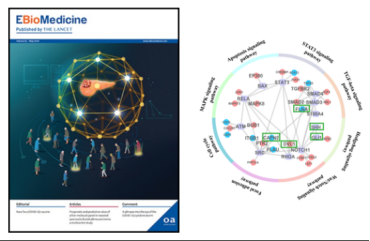Pancreatic cancer has an insidious onset and a high degree of malignancy, and is commonly known as "the king of cancer". According to the statistics of the National Cancer Center in 2018, the five-year survival rate (7.2%) for patients suffering from pancreatic cancer was the lowest among all tumors in China. The efficacy of postoperative chemotherapy is an important factor that affects the prognosis of pancreatic cancer patients. Finding markers of accurate chemotherapy after pancreatic cancer surgery and accurately screening patients who benefit from chemotherapy may improve the survival rate of the patients. However, due to the complex mechanism of pancreatic cancer, there is still a lack of biomarkers to guide the precise drug use of postoperative chemotherapy for pancreatic cancer, especially those suitable for the Chinese population. As biomedical research enters the era of artificial intelligence and big data, the discovery of highly accurate biomarkers of pancreatic cancer through systematic and computational prediction globally has become a challenging frontier issue.
Recently, Prof. Li Shao's research team from the Department of Automation cooperated closely with the team led by Prof. Zhao Yupei, President of Peking Union Medical College Hospital, discovering the first marker of postoperative precision chemotherapy for pancreatic cancer that has been verified in Chinese population by multiple clinic centers. The marker discovered by Zhao Yupei's team and Li Shao's team has been granted China's invention patent (patent No.: ZL201611038981.4). In May 2020, the finding was published as a cover paper in EBiomedicine, which is a journal under The Lancet (an international renowned clinical journal) and is indexed in the top tier of the SCI medical journals.. Zhang Peng (a PhD student from the Department of Automation, Tsinghua University), Guo Junchao, Zhou Li and You Lei from Peking Union Medical College Hospital are the co-first authors of the paper, and Li Shao, Guo Junchao and Zhang Taiping are the co-corresponding authors of the paper.

Figure 1. Molecular network of pancreatic cancer and markers of postoperative precision chemotherapy. The cover paper is on the left (designed by Prof. Li Shao and Zhang Peng). By combining intelligent computation with multicenter clinical trials, a group of biomarkers composed of five molecules can be found to accurately identify those who are at high risk after subjecting to pancreatic cancer operation and those who benefit from chemotherapy. The figure on the right shows the molecular network of biomarkers and their associated signaling pathways predicted by intelligent computation.
The discovery of this marker is an achievement of the combination of intelligent computation and multi-center clinical trials, which is an important breakthrough in computational methodology. Li Shao's research team used CIPHER, a self-developed pathogenetic relationship inference algorithm, to predict the pathogenetic genes of pancreatic cancer genome-wide. They integrated multi-level omics data and prior knowledge of pancreatic cancer to construct a molecular network related to malignant progression of pancreatic cancer, and successfully predicted a group of biomarker combinations located within pathways such as TGFβ, Hedgehog and Wnt, which are closely related to the prognosis of pancreatic cancer. Three of these molecules (FLNA, DVL1, and CAPN2) were discovered to be associated with pancreatic cancer prognosis and chemotherapy for the first time.
606 clinical samples of the marker were verified at multiple centers by Peking Union Medical College Hospital, Renji Hospital and the First Affiliated Hospital of Harbin Medical University, and it was found that the marker has the following four advantages: 1. High reliability: it is the first marker of precision chemotherapy after pancreatic cancer surgery verified by pancreatic cancer population in China from multiple centers; 2. High prediction accuracy: It is significantly better than the existing clinical tumor marker CA19-9, and significantly improved the prognostic performance of the traditional clinical pathological indicators (P < 0.001); 3. It can accurately screen out the beneficiaries of chemotherapy, and the median survival of this population after receiving the chemotherapy based on Gemcitabine (gemcitabine hydrochloride) significantly increased by nearly 5 months (P < 0.01); 4. It can accurately identify the population with a very poor prognosis, and the overall survival risk for this population more than doubled dramatically.

Figure 2. Multicenter clinical verification of biomarkers. Figure A shows the correlation of assessment and prognosis of biomarker samples in three independent clinical centers; Figure B shows the comparison of the predictive performance of biomarkers and clinical tumor indicators (CA19-9); Figure C shows the prognostic analysis of those who benefited from chemotherapy and those who did not, as distinguished by biomarker identification.
The research on this marker was supported by the 863 Project and the key project of the National Natural Science Foundation of China (NSFC). Currently, the development of the test kit and the prospective clinical cohort study is underway, which is expected to achieve accurate diagnosis and treatment of pancreatic cancer and improve the survival rate of patients after surgery. The result also highlights the advantages of AI in the discovery of new tumor markers and provides an important demonstration for the network pharmacology research on precision chemotherapy of pancreatic cancer.
The research team led by Professor Li Shao from the Department of Automation, Tsinghua University and Beijing National Research Center for Information Science and Technology has long been committed to studying the genesis and development mechanism of tumor and its biomarkers from the systematic perspective of "biological network", and explaining the network pharmacological mechanism of Chinese and Western medicine. Recently, the team has made a breakthrough in intelligent early warning and very early diagnosis and treatment of gastric cancer, which has been selected as the Top 10 Applications of Bioinformatics in China and the Top 10 Headlines of Academic Topics in the China Association of Chinese Medicine in 2019.
The paper can be found at https://www.thelancet.com/journals/ebiom/article/PIIS2352-3964(20)30142-0/fulltext.

